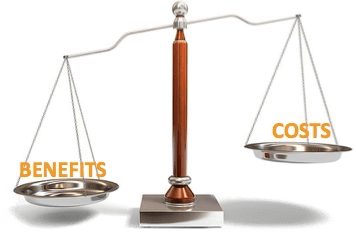
In the course of business, there is usually a point where a large outlay of cash is considered to either reduce costs by improving efficiency, or to expand into new areas and increase revenues. It can be difficult to discern the best course of action without getting emotionally involved. One proven method of determining whether to move forward is to do a “cost-benefit analysis” or CBA.
A CBA is a detailed rundown of the potential gains as well as the costs of a project. In this approach, all the strengths and weaknesses of various alternatives are converted into monetary terms, if at all possible, and then compared to determine the best alternative. The process may sound difficult, but if approached in a systematic way, it is possible for anyone to perform this analysis.
So how can we start? Here are five main ideas to keep in mind while calculating a CBA:
1. Put a dollar value on everything. For many items, assigning a monetary amount is easy. But for other aspects, we have to make assumptions. There are risks associated with putting a monetary value on non-monetary benefits. For example, valuing decreased warehouse time or increased production can be difficult. In general, the more realistic or conservative the estimate, the better.
2. Write down your assumptions on paper. A simple Excel spreadsheet is a handy tool to keep track of the details, and it will maintain totals for the costs and benefits. List all the costs, benefits, and other assumptions on your spreadsheet. For example, estimating the life of the equipment at a certain number of years should be documented.
3. Consider all benefits, including reduced operating costs and increased revenue. Make a list of all benefits associated with the proposed purchase and then assign a monetary value to each benefit. Remember that reducing operating costs is a benefit for this category.
4. List all costs associated with the project. The budget for the project should include all costs associated with it, some of which may not be obvious. For example, it does no good to have an additional piece of equipment if there is not an additional employee to operate it. Be sure to include this additional salary in the cost of the analysis. If you are financing the outlay, the interest expense should be included. All of these costs should be added together.
5. Subtract all the costs from all the benefits. If the benefits outweigh the costs of the project, consider moving forward. If the costs far outweigh the potential benefits, however, the investment is probably not worthwhile at this time.
Consider the following real-life example from one of Lucrum’s clients. A company in the pavement and concrete industry was considering whether to purchase a new skid-steer loader or to continue to lease the equipment whenever they needed an extra machine. As part of the analysis, the two options (continue renting v. buy) were both considered and then a determination was made as to which option was the most cost effective. In this case, the two options both cost the company, but one had lower costs than the other. Here is a simplified sample of our analysis:
| Purchase Price | 59,800 |
| Add: | |
| Trailer | 7,000 |
| Hammer | 5,000 |
| Total Cost of Purchase | 71,800 |
| Residual 15% in 10 yrs | (10,770) |
| New Cost – new machine | 61,030 |
| Useful Life (est) | 10 |
| Cost per Year – Purchase | 6,100 |
| Estimated maint cost/yr | 8,200 |
| Cost per Year – Buy | 14,300 |
| Cost per Year – Rent | 22,100 |
| Savings with Buy Option | 7,800 |
In this instance, the company moved forward with confidence that purchasing a new skid-steer loader was a good investment from a cost savings standpoint, regardless of any increased revenue or more efficient operations.
Although this computation may appear a bit detailed, the information contained in those details are most likely already something you know if considering a big purchase. Now just put information on paper and do a little math!
There are many ways to approach the calculation of the cost of options when considering a large purchase, and there is not just one correct way. Consider trying a cost benefit analysis the next time a decision needs to be made regarding a large purchase. Or give Lucrum a call and we’ll be happy to help.

Should I Use The Same Company for CFO and Bookkeeping Services or Keep Them Separate?
by Lucrum Staff Is your company considering outsourcing fractional CFO and bookkeeping services to two different companies? Using a single provider for …

Do I Need a Fractional CFO, Interim CFO or Part-Time CFO? What’s the Difference?
by: Lucrum Staff As a business scales, it reaches a point where more financial expertise is needed than existing resources can provide. …

When To Politely Turn Down A New Business Opportunity
By: Jeff Heybruck New business opportunities are, for good reason, exciting. But wise business leaders are able to take off the rose-colored …
